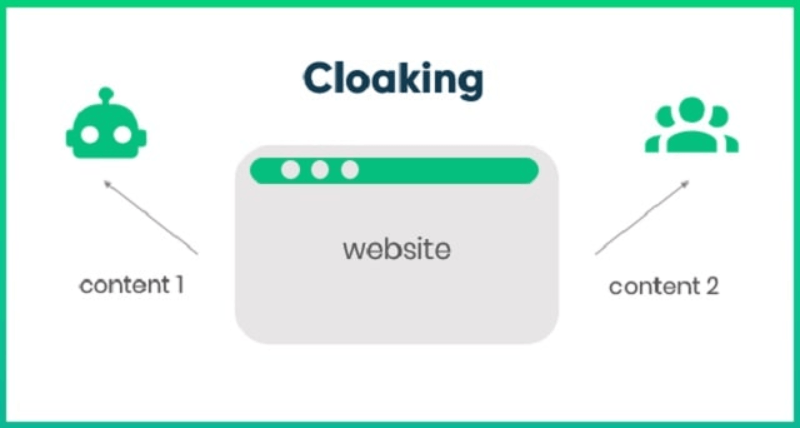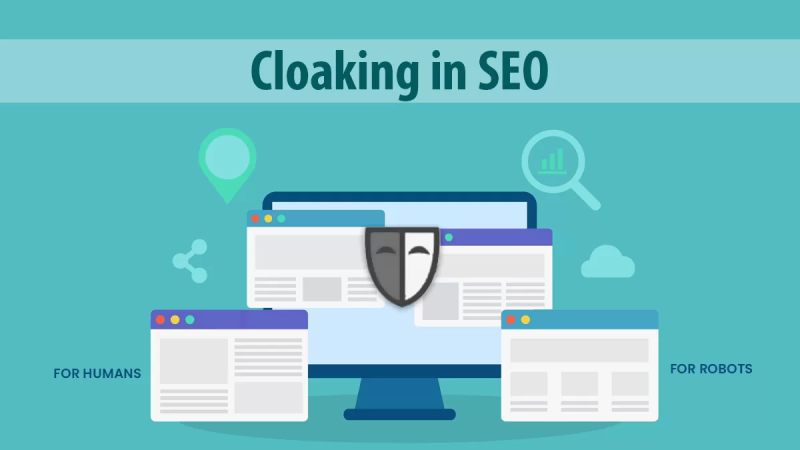
Cloaking in SEO means displaying a different page or presenting different addresses to the user and search engines. This technique can be ethically regarded as some kind of virtual deception, where the purpose is to influence the position of the specific website within the search engine while hiding its actual content.
This means while using this method can indeed bring in instant benefits, it is practically filled with risks and ethical loopholes and can get your website banned by search engines.
Explaining, Cloaking in SEO is the process by which search engine result pages display different contents or hyperlinks to different pages depending on the original query submitted by the user.
Website cloaking is commonly defined as the act of providing search engines with content/information that is different from what is provided to the users.
For instance, to a search engine, a site might show a set of keywords to enable the site to rank higher when users search for content. However, users see an attractive page depicting different content. The major purpose of cloaking is to enhance the site and its ranking by lying to the algorithms of a particular search engine.
How Does Cloaking Work in SEO?

The general operation of cloaking is to analyze the user agent accessing the page through a request in the server. In particular, when the serving engine recognizes a SE bot it serves a copy of the page that is tweakable for SE algorithms. On the other hand, if a human visitor has arrived at the page, he or she is provided with content suitable for viewing.
- User-Agent Detection: This enables the server to identify the ‘user agent’ of the visitor and know if it is a web crawler, spider or a real human being.
- IP Delivery: There are two blocks of text, one is for search engine bots, and another is for a normal human user, which depends on their IP address.
Types of Cloaking in SEO

- Content Cloaking: An effective use of the Effect: providing different content to search engines and users. This form of cloaking is the most frequently used one; also known as the ‘site deep cloaking.
- Image Cloaking: Linking to a different website than the one the user sees, or providing some content in one language while having it translated into another for a search engine.
- URL Cloaking: A practice of guiding the search engine bots to pages other than the ones that are regularly utilised by the visitors.
The Risks of Cloaking

The major negative effects as a result of cloaking include the fact that it implies a direct violation of the rules set by search engines. The major risks include:
- Search Engine Penalties: Google among other search engines regards cloaking as a severe offence to their policy. Any site that is found guilty of cloaking may suffer different fines and may be removed from the search engine lists.
- Loss of Trust: Generally once a website has been blacklisted regaining the confidence of both Google and users is a very difficult thing to do. This can mean a dramatic decrease in the number of customers and eventually, the money they bring, to the business.
- Ethical Concerns: Cloaking more often than not is considered a form of SEO manipulation which is unethical. They mislead both search engines and users, which distorts the web environment and the latter’s honesty.
When Cloaking Might Be Used

However, there are some situations, which might encourage the application of cloaking, even though these are usually rather controversial. These include:
- Content Localization: Delivering different web content to the viewers depending on the geographic location for the purpose of localisation.
- A/B Testing: Delivering the same webpage with variation to several users for performance tests, which is rather risky and should not be done too often to avoid being regarded as cloaking.
Ethical Alternatives to Cloaking

- Dynamic Serving: Some of the possible techniques – present different HTML and CSS for PC, PDA ontology, etc, for the same URL it is not possible if done correctly – cloaking.
- User-Centric Content: Write/prepare good-material content that would otherwise go viral and be relevant to users as well as search engines. This entails proper keyword optimization, involving multimedia and the structure of the site as well.
Case Study: The Following Are The Repercussions Of Cloaking
- Scenario: Some e-business firm uses cloaking in a wrong manner by presenting keyword-saturated web pages to the search engines but presenting user-friendly, well-organized product website pages to the users. This is so since the site gains higher rankings in the search engine and experiences a sudden rush of traffic to the site.
- Outcome: Google has the ability to identify the act of cloaking. The site becomes penalized and this leads to a loss of hard-earned positions in search engines. Visitation sources drop, and the site may be deemed as a useless one by the users. Recovery entails a lot of cleaning and compliance activities, which take time as well as money to accomplish.
Conclusion
Though it is considered as a strategic approach to increase the websites’ rankings for a short-term period, cloaking is a very risky technique that can have severe consequences in future. Search engines are constantly developing their algorithms to identify ineffective and, more specifically, unethical SEO strategies and effectively penalize them; thus, practising ethical SEO strategies is not only good for business, but it is also beneficial for long-term sustainability and prosperity. Thus, the issues of providing quality content, working on responsive design, and increasing user satisfaction let webmasters achieve all the necessary SEO objectives without cheating and facing sanctions.
For digital marketing professionals and businesses, the lesson is clear: ethical SEO methods are among the finest foundations for any long-term online business strategy. Cloaking might seem like the Holy Grail of SEO but power and effectiveness are earned honestly, with White Hat SEO.
For any marketer keen on mastering the know-how of digital marketing, these aspects of cloaking are rather important since such techniques and their related risks and ethical issues change constantly. As learned from DigiExcel’s case, when entering into the SE market, SEOs should be willing to adopt and stick to standard and ethical practices as this will guarantee them a sound reputation and longevity in the market.




